|
|
 |
|
Calanoida ( Order ) |
|
|
|
Diaptomoidea ( Superfamily ) |
|
|
|
Candaciidae ( Family ) |
|
|
|
Candacia ( Genus ) |
|
|
| |
Candacia bipinnata (Giesbrecht, 1889) (F,M) | |
| | | | | | | Syn.: | Candace bipinnata Giesbrecht,1889; 1892 (p.424, 439, 771, figs.F);
Candacia pectinata : Esterly, 1905 (p.193, figs.F,M); Mori, 1937 (1964) (p.83, figs.M); Dakin & Colefax, 1940 (p.105, figs.F,M); ? Honjo, 1952; ? Honjo & al., 1957; ? Ohtsuka & Kubo, 1991 (p.541); ? Hattori, 1991 (tab.1, Appendix); Mendoza Portillo, 2013 (p.37: fig.7 as peptinata, p.42: fig.10, biomass) | | | | Ref.: | | | Giesbrecht & Schmeil, 1898 (p.129, Rem. F); Esterly, 1905 (p.195, figs.F); A. Scott, 1909 (p.151, Rem.); Sars, 1925 (p.351); Mori, 1929 (p.176, figs.F, M); Rose, 1929 (p.40, figs.F,M, Rem.); Farran, 1929 (p.210, 272); Dakin & Colefax, 1933 (p.206); Rose, 1933 a (p.254, figs.F,M); Tanaka, 1935 a (p.210, figs.F,M); Mori, 1937 (1964) (p.86, figs.F,M); Dakin & Colefax, 1940 (p.105, figs.F); Lysholm & al., 1945 (p.41); Sewell, 1947 (p.246); Davis, 1949 (p.62, figs.F,M); Brodsky, 1950 (1967) (p.406, figs.F,M); Chiba, 1956 (p.36, p.62, figs. Juv.M , figs.F,M, Rem.); Chiba & al., 1957 a (p.11); Tanaka, 1960 (p.54); Brodsky, 1962 c (p.134, figs.F,M); Grice, 1962 (p.231, figs.M, Rem.); Mazza, 1962 (p.342); Paiva, 1963 (p.66, figs.M); Crisafi, 1963 (p.123, figs.F,M, juv.); Grice, 1963 (p.174); Tanaka, 1964 c (p.243); De Decker, 1964 (p.15, 18: Rem.); Vervoort, 1965 (p.159, Rem.); Chen & Zhang, 1965 (p.92, figs.F,M); Owre & Foyo, 1967 (p.92, figs.F,M); Vidal, 1968 (p.39, figs.F); Park, 1968 (p.566, figs.F,M); Corral Estrada, 1970 (p.195, figs.F,M, Rem.); Itoh, 1970 (tab.1, figs. Md, Mx2); Shih & al., 1971 (p.37, 146); Kos, 1972, Vol. I, figs.F, M, Rem.); Lawson, 1977 (p.71, tab.2 ,3, 4, fig.5); Dawson & Knatz, 1980 (p.8, figs.F,M); Björnberg & al., 1981 (p.657, figs.F,M); Gardner & Szabo, 1982 (p.404, figs.F,M); Zheng & al., 1982 (p.68, figs.F,M); Ohtsuka & Onbe, 1989 (p.869, fig.1, mouthparts, feeding); Schnack, 1989 (p.137, tab.1, fig.6: Md); Chihara & Murano, 1997 (p.752, Pl.73,77: F,M); Mulyadi, 1997 a (p.76, Redescr.F,M, figs.F,M); Vaupel Klein & Gassmann, 1998 (p.443, fig.M); Bradford-Grieve & al., 1999 (p.885, 956, figs.F,M); Bradford-Grieve, 1999 b (p.161, figs.F,M, Rem., figs.182, 193); G. Harding, 2004 (p.26, figs.F,M); Mulyadi, 2004 (p.79, figs.F,M, Rem.); Vives & Shmeleva, 2007 (p.445, figs.F,M, Rem.) |  issued from : O. Tanaka in Suisan Gakkai Ho, Tokyo, 1935, 6 (4). [Pl.I, p.217]. Female: 1, habitus (dorsal view); 2, last thoracic segment and urosome (right lateral view); 3, A1 (proximal portion); 4, Mx2; 5, segment 3 of exopodite of P3; 6, P5. Male: 7, last thoracic segment and urosome (dorsal view); 8, right A1 (hinge segments); 9, P5 (left and right)
|
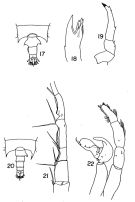 Issued from : T.S. Park in Fishery Bull. Fish Wild. Serv. U.S., 1968, 66 (3). [p.565, Pl.12, Figs.17-22]. Female: 17, last thoracic segment and urosome (dorsal); 18, Md (masticatory edge); 19, P5. Male: 20, last thoracic segment and urosome (dorsal); 21, geniculated region of right A1; 22, P5 (posterior).
|
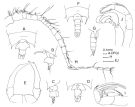 issued from : Bradford-Grieve J.M. in The Marine Fauna of New Zealand: Pelagic Calanoid Copepoda. National Institute of Water and Atmospheric Research (NIWA). NIWA Biodiversity Memoir, 111, 1999. [p.166, Fig.115]. Female: A, urosome (dorsal); B, idem (left side); C, idem (right side); D, idem (ventral); E, P5. Male: F, urosome (dorsal); G, idem (right side); H, right A1; I, Mx1; J, P5. Male Nota: Mx2 basipod 2 proximal spine not notably thicker than the distal spine.
|
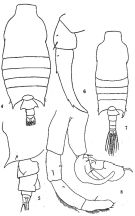 issued from: Q.-c Chen & S.-z. Zhang in Studia Marina Sinica, 1965, 7. [Pl.37, 4-8]. Female (from E China Sea): 4, habitus (dorsal); 5, urosome (lateral right side); 6, left P5 (posterior). Male: 7, habitus (dorsal); 8, P5 (posterior).
|
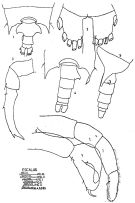 issued from : J. Corral Estrada in Tesis Doct., Univ. Madrid, A-129, Sec. Biologicas, 1970. [Lam.51, figs.1-6]. Female (from Canarias Is.): 1, postrior part cephalothorax and urosome (dorsal); 2, caudal rami (dorsal); 3, P5. Male: 4, postrior part cephalothorax and urosome (dorsal); 5, idem (lateral right side); 6, P5.
|
 issued from : S. Ohtsuka & R. Huys in Hydrobiologia, 2001, 453/454. [p.456, Fig.10, C-D]. Male (from Japan): C, urosome (putative cleaning device and gonopore indicated by large and small arrow, respectively); D, putative cleaning device. Scale bars: 0.1 mm (C); 0.01 mm (D). Nota: The right lateral process on the genital somite bears a fingerprint-like structure. This structure could serve as auxiliary devices, however, the copulatory behaviour must be directly observed in order to reveal their precise function. These putative cleaning devices are associated with mechanoreceptors such as peg- and hair-sensilla which suggests that grooming may also be important during mating.
|
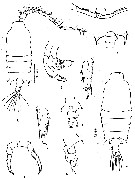 issued from : Z. Zheng, S. Li, S.J. Li & B. Chen in Marine planktonic copepods in Chinese waters. Shanghai Sc. Techn. Press, 1982 [p.69, Fig.39]. Female: a, habitus (dorsal); b, urosome (lateral, left side); c, idem (ventral); d, exopodite segment 3 of P3; e, P5. Male: f, habitus (dorsal); g, genital segment ( (dorsal); h, grasping part of right A1; i, exopodite segment 3 of P3; j, P5. Scale bars in mm.
|
 issued from : C.O. Esterly in Univ. Calif. Publs. Zool., 1905, 2 (4). [p.194, Fig.44]. As Candacia pectinata. Female (from San Diego Region): b, P5; d, P4. Male: a, last thoracic segment and 1st and 2nd abdominal segments (dorsal); c, 3rd segment of exopod of P3.
|
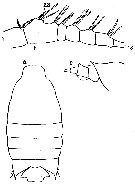 issued from : C.O. Esterly in Univ. Calif. Publs. Zool., 1905, 2 (4). [p.195, Fig.45]. Female (from San Diego Region): a, cepphalothorax and genital segment (dorsal); b, A1 (segments 1 to 8); c, last thoracic segment and urosome.
|
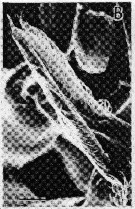 issued from : S. Ohtsuka & R. Huys in Hydrobiologia, 2001, 453/454. [p.452, Fig.7, B]. Male: B, terminal exopodal segment of left P5. Scale bar: 0.2 mm.
|
 issued from : M. Rose in Result. Camp. Scient. Price Albert Ier, Monaco, 1929, 78. [Pl.II, Figs.6]. Female (from Canary Is-Madeira--Azores): D, habitus (dorsal); P5; A1. Male: A1.
|
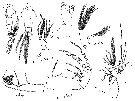 issued from : M. Rose in Result. Camp. Scient. Price Albert Ier, Monaco, 1929, 78. [Pl.III, Figs.6]. Female: Ab D, urosome with spermatophore (dorsal); Ab L, urosome (lateral); A2; Md (a and b from different scale); Mx1 (as Mx); Mx2 (as Mxp1); Mxp (as Mxp2).
|
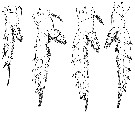 issued from : M. Rose in Result. Camp. Scient. Price Albert Ier, Monaco, 1929, 78. [Pl.III, Figs.6]. Female: P1 to P4.
|
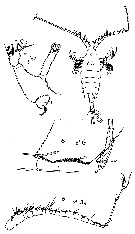 issued from : M. Rose in Result. Camp. Scient. Price Albert Ier, Monaco, 1929, 78. [Pl.III, Figs.6]. Male: D, habitus (dorsal); A2; A1 (right); G, geniculation of right A1.
|
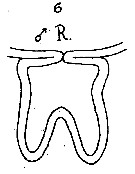 issued from : M. Rose in Result. Camp. Scient. Price Albert Ier, Monaco, 1929, 78. [Pl.III, Figs.6]. Male: R, rostrum.
|
 issued from : M. Rose in Result. Camp. Scient. Price Albert Ier, Monaco, 1929, 78. [Pl.III, Figs.6]. Male: Ab, urosome (dorsal); Md; Mx1 (as Mx); Mx2 (as Mxp1); Mxp (as Mxp2); P1 to P5.
|
 issued from : T. Mori in Zool. Mag. Tokyo, 1929, 41 (486-487). [Pl. VII, Figs.2-4]. Female (from Chosen Strait, Korea-Japan): 3, urosome ( (ventral). Male: 2, P3;
|
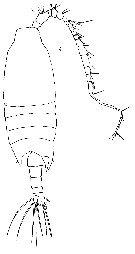 issued from : T. Mori in Zool. Mag. Tokyo, 1929, 41 (486-487). [Pl. VII, Fig.4]. Male: 4, habitus (dorsal).
|
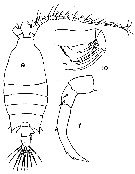 issued from : T. Mori in The Pelagic copepoda from the neighbouring waters of Japan, 1937 (1964). [Pl. 58, Figs.7, 9, 10]. Female: 7, P5; 9, habitus (dorsal); 1,, Mx2.
|
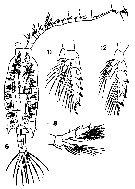 issued from : T. Mori in The Pelagic copepoda from the neighbouring waters of Japan, 1937 (1964). [Pl. 58, Figs.6, 8, 11, 12]. Male: 6, habitus (dorsal); 8, P1; 11, P3; 12, P4.
|
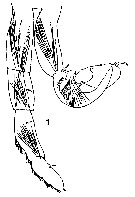 issued from : T. Mori in The Pelagic copepoda from the neighbouring waters of Japan, 1937 (1964). [Pl. 59, Fig.1]. Male: 1, P5.
|
 issued from : T. Mori in The Pelagic copepoda from the neighbouring waters of Japan, 1937 (1964). [Pl. 55, Figs7-12.]. As Candacia pectinata. Male: 7, terminal portion of right P5; 8, Mx2; 9, P3; 10, P5; 11, right A1; 12, habitus (dorsal).
|
 issued from : G.D. Grice in Fish. Bull. Fish and Wildl. Ser., 1962, 61. [p.233, Pl.31, Figs.4-7]. Male (from equatorial Pacific): 4, posterior part of thorax and abdominal segments 1 and 2 (dorsal); 5, posterior part of thoracic segment and genital segment (right side); 6, Md (biting edge); 7, P5. A small, posteriorly directed hook arises from the right side of the genital segment .
The basal tooth of Md is tricuspate.
The thumb of the chela of right P5 with a stout spine at its tip.
|
 issued from : G. Harding in Key to the adullt pelagic calanoid copepods found over the continental shelf of the Canadian Atlantic coast. Bedford Inst. Oceanogr., Dartmouth, Nova Scotia, 2004. [p.26]. Female & Male. Nota: Female with lamella on ventral surface of urosomal segment 2 (arrowed).
|
 issued from : S.B. Schnack in Crustacean Issue, 1989, 6. [p.143, Fig.6: 13]. 13, Candacia bipinnata (from off NW Africa, upwelling region): Cutting edge of Md.
|
 issued from : Mulyadi in Published by Res. Center Biol., Indonesia Inst. Sci. Bogor, 2004. [p.79, Fig.44]. Female (from Kupang Sea): A, habitus (dorsal); B, 5th metasomal somite and urosome (lateral right side); C, A1; D, Mx2; E, P5. Male: F, habitus (dorsal); G, 5th metasomal somite and urosome (dorsal); H, 16th to 19th segments of right A1; I, P5 (posterior view).
|
 Issued from : J.M. Bradford-Grieve, E.L. Markhaseva, C.E.F. Rocha & B. Abiahy in South Atlantic Zooplankton, edit. D. Boltovskoy. 1999, Vol. 2, Copepoda; [p.1064, Fig. 7.362: Candacia bipinnata ]. Ur = urosome; Gns = genital segment. Female characteristics (from key, p.956) : - In dorsal view, lateral margins of genital segment large triangular and pointed extension on each side. - Urosomal segment 2 with a lamella on ventral surface. - Posterior corners of prosome pointed. Male characteristics (from key, p.956) : In lateral view, distal end of right posterior corner of prosome truncate, extending beyond posterior border of genital segment. - Right A1 with segments 19 and 20 fused. - Right A1 with segments 17 and 18 separate. - Right A1 with segments 2 and 3 fused. - In dorsal view, genital segment with process.
|
 Issued from : W. Giesbrecht in Fauna Flora Golf. Neapel, 1892, 19. [Taf. 39, fig. 29]. As Candace bipinnata. Female: 29, thoracic segment 5 a,d abdominal segments 1 and 2. (lateral).
|
 Issued from : W. Giesbrecht in Fauna Flora Golf. Neapel, 1892, 19. [Taf. 39, fig. 27]. As Candace bipinnata. Female: 27, urosome (ventral).
|
 Issued from : M.C. Kos in Field guide for plankton. Zool Institute USSR Acad., Vol. I, 1972. After Brodsky, 1952, 1962. Female: 1, habitus (dorsal); 2, corner of the last thoracic segment and abdomen; 3, same (lateral); 4, P5. Male: 5, habitus (dorsal); 6, corner of the last thoracic segment and abdomen (dorsal); 7, right A1 (grasping segments); 8, P5.
| | | | | Compl. Ref.: | | | Cleve, 1904 a (p.186); Rose, 1925 (p.152); 1926 (p.47); Wilson, 1942 a (p.174); Oliveira, 1945 (p.191); Sewell, 1948 (p.391, 396, 408, 414, 422, 443, 450, 460, 467, 469); C.B. Wilson, 1950 (p.180); Kott, 1957 (p.6, 18); Yamazi, 1958 (p.151, Rem.); Fagetti, 1962 (p.32); Cervigon, 1962 (p.181, tables: abundance distribution); Giron-Reguer, 1963 (p.37); Ahlstrom & Thrailkill, 1963 (p.57, Table 5, abundance); Gaudy, 1963 (p.28, Rem.); Björnberg, 1963 (p.56, Rem.); De Decker & Mombeck, 1964 (p.11); Anraku & Azeta, 1965 (p.13, Table 2, fish predator); Grice & Hulsemann, 1965 (p.225); Furuhashi, 1966 a (p.295, vertical distribution in Kuroshio region, Table 10); Mazza, 1966 (p.72); 1967 (p.367); Ehrhardt, 1967 (p.741, geographic distribution, Rem.); Fleminger, 1967 a (tabl.1); Séguin, 1968 (p.488); De Decker, 1968 (p.45); Morris, 1970 (p.2301); Timonin, 1971 (p.281, trophic group); Deevey, 1971 (p.224); Binet & al., 1972 (p.69); Bainbridge, 1972 (p.61, Appendix Table III: occurrence); Roe, 1972 (p.277, tabl.1, tabl.2); Björnberg, 1973 (p.349, 384); Corral Estrada & Pereiro Muñoz, 1974 (tab.I); Peterson & Miller, 1975 (p.642, 650, Table 3 occurrence); Vives & al., 1975 (p.52, tab.II); Peterson & Miller, 1976 (p.14, Table 1, 2, 3, abundance vs interannual variations); 1977 (p.717, Table 1, seasonal occurrence); Tranter, 1977 (p.596, 600); Deevey & Brooks, 1977 (p.156, tab.2, Station "S"); Carter, 1977 (1978) (p.36); Dessier, 1979 (p.206); Vaissière & Séguin, 1980 (p.23, tab.2); Vives, 1982 (p.294); Kovalev & Shmeleva, 1982 (p.85); Dessier, 1983 (p.89, Tableau 1, Rem., %); Tremblay & Anderson, 1984 (p.4); Guangshan & Honglin, 1984 (p.118, tab.); De Decker, 1984 (p.317, 335: chart); Scotto di Carlo & al., 1984 (1045); Regner, 1985 (p.11, Rem.: p.37); Brenning, 1985 a (p.24, Table 2); Brinton & al., 1986 (p.228, Table 1); Chen Y.-Q., 1986 (p.205, Table 1: abundance %, Table 2: vertical distribution); Madhupratap & Haridas, 1986 (p.105, tab.1); Rudyakov, 1986 (tab.1); Valentin & al., 1986 (p.117, Table V); Brenning, 1987 (p.29, spatial distribution, T-S diagram, Rem.); Lozano Soldevilla & al., 1988 (p.60); Cervantes-Duarte & Hernandez-Trujillo, 1989 (tab.3); Heinrich, 1990 (p.19); Suarez & al., 1990 (tab.2); Hirakawa & al., 1990 (tab.3); Ohtsuka & Kubo, 1991 (p.538); Hattori, 1991 (tab.1, Appendix); Samba Diouf, 1991 (p.103, tableau 1); Yoo, 1991 (tab.1); Hernandez-Trujillo, 1991 (1993) (tab.I); Suarez & Gasca, 1991 (tab.2); Suarez, 1992 (App.1); Seguin & al., 1993 (p.23, 26: Rem.); Landry & al., 1994 (p.55, abundance, grazing); Shih & Young, 1995 (p.68); Kotani & al., 1996 (tab.2); Park & Choi, 1997 (Appendix); Hure & Krsinic, 1998 (p.102); Suarez-Morales & Gasca, 1998 a (p108); Noda & al., 1998 (p.55, Table 3, occurrence); Hernandez-Trujillo, 1999 (p.284, tab.1); Dolganova & al., 1999 (p.13, tab.1); Bragina, 1999 (p.196); Lapernat, 2000 (tabl.3, 4); Seridji & Hafferssas, 2000 (tab.1); Escribano & Hidalgo, 2000 (p.283, tab.2); Hidalgo & Escribano, 2001 (p.159, tab.2); Rebstock, 2001 (tab.2); 2002 (p.71, Table 3, Fig.4: climatic variability); Yamaguchi & al., 2002 (p.1007, tab.1); Beaugrand & al., 2002 (p.179, figs.5, 6); Keister & Peterson, 2003 (p.341, Table 1, abundance, cluster species vs hydrological events); Hsiao & al., 2004 (p.325, tab.1); Lo & al., 2004 (p.89, tab.1); Osore & al., 2004 (p.195); Dias & Araujo, 2006 (p.34, Rem., chart); Lavaniegos & Jiménez-Pérez, 2006 (p.137, tab.2, 3, Rem.); Mackas & al., 2006 (L22S07, Table 2); Hooff & Peterson 2006 (p.2610); Papastephanou & al., 2006 (p.3078, Table 3); Hwang & al., 2007 (p.23); Dur & al., 2007 (p.197, Table IV); Khelifi-Touhami & al., 2007 (p.327, Table 1); McKinnon & al., 2008 (p.843: Tab.1); Ayon & al., 2008 (p.238, Table 4: Peruvian samples); Gaard & al., 2008 (p.59, Table 1, N Mid-Atlantic Ridge); Galbraith, 2009 (pers. comm.); C.E. Morales & al., 2010 (p.158, Table 1); Hafferssas & Seridji, 2010 (p.353, Table 3); Hernandez-Trujillo & al., 2010 (p.913, Table 2); Dias & al., 2010 (p.230, Table 1); Schnack-Schiel & al., 2010 (p.2064, Table 2: E Atlantic subtropical/tropical); Hidalgo & al., 2010 (p.2089, Table 2); Mazzocchi & Di Capua, 2010 (p.424); Medellin-Mora & Navas S., 2010 (p.265, Tab. 2); Hsiao S.H. & al., 2011 (p.475, Appendix I); Batten & Walne, 2011 (p.1643, Table I, abundance vs temperature interannual variability); Tutasi & al., 2011 (p.791, Table 2, abundance distribution vs La Niña event); Takenaka & al., 2012 (p.1669, fig.2, 3, Table 1, bioluminescence); Takahashi M. & al., 2012 (p.393, Table 2, water type index); Teuber & al., 2013 (p.1, Table 2, respiration rates); Palomares-Garcia & al., 2013 (p.1009, fig.7); in CalCOFI regional list (MDO, Nov. 2013; M. Ohman, pers. comm.); Tseng & al., 2013 (p.507, seasonal abundance); Schukat & al., 2013 (p.1, Table 1, fig.2, respiration, ingestion); Lidvanov & al., 2013 (p.290, Table 2, % composition); Bonecker & a., 2014 (p.445, Table II: frequency, horizontal & vertical distributions); Dias & al., 2015 (p.483, Table 2, abundance, biomass, production); Zakaria & al., 2016 (p.1, Table 1, Rem.); Benedetti & al., 2016 (p.159, Table I, fig.1, functional characters); Ben Ltaief & al., 2017 (p.1, Table III, Summer relative abundance); El Arraj & al., 2017 (p.272, table 2, spatial distribution); Belmonte, 2018 (p.273, Table I: Italian zones); Chaouadi & Hafferssas, 2018 (p.913, Table II: occurrence); Hirai & al., 2020 (p.1, Fig. 5: cluster analysis (OTU), spatial distribution). | | | | NZ: | 19 | | |
|
Distribution map of Candacia bipinnata by geographical zones
|
| | | | | | | | | | | |  issued from : T.J. Lawson in Marine Biology, 1977, 43. [Fig.5, p.80]. issued from : T.J. Lawson in Marine Biology, 1977, 43. [Fig.5, p.80].
Distribution map for the Indian Ocean. |
 issued from : Mulyadi in Treubia, 1997, 31 (2). [p.109, Fig.16]. issued from : Mulyadi in Treubia, 1997, 31 (2). [p.109, Fig.16].
Distribution of Candaciidae in Indonesian waters. 1: C. bipinnata. |
 issued from : C. de O. Dias & A.V. Araujo in Atlas Zoopl. reg. central da Zona Econ. exclus. brasileira, S.L. Costa Bonecker (Edit), 2006, Série Livros 21. [p.34]. issued from : C. de O. Dias & A.V. Araujo in Atlas Zoopl. reg. central da Zona Econ. exclus. brasileira, S.L. Costa Bonecker (Edit), 2006, Série Livros 21. [p.34].
Chart of occurrence in Brazilian waters (sampling between 22°-23° S).
Nota: sampling only 1 specimen. |
 issued from : U. Brenning in Wiss. Z. Wilhelm-Pieck-Univ. Rostock - 36. Jahrgang 1987. Mat.-nat. wiss. Reihe, 2. [p.27, Fig.1]. issued from : U. Brenning in Wiss. Z. Wilhelm-Pieck-Univ. Rostock - 36. Jahrgang 1987. Mat.-nat. wiss. Reihe, 2. [p.27, Fig.1].
Spatial distribution for Candacia curta, C. armata, C. bipinnata, C. paenelongimana, C. varicans (as varians), C. pachydactyla, C. longimana, C. ethiopica, Paracandacia simplex ( = C. simplex) from 8° S - 26° N; 16°- 20° W, for different expeditions (V1: Dec. 1972- Jan. 1973; V2: Feb/Mar. 1973; VI: May 1974; IV: Jun./Jul. 1972). |
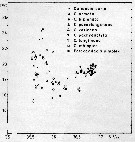 issued from : U. Brenning in Wiss. Z. Wilhelm-Pieck-Univ. Rostock - 36. Jahrgang 1987. Mat.-nat. wiss. Reihe, 2. [p.28, Fig.2]. issued from : U. Brenning in Wiss. Z. Wilhelm-Pieck-Univ. Rostock - 36. Jahrgang 1987. Mat.-nat. wiss. Reihe, 2. [p.28, Fig.2].
T-S Diagram for Candacia curta, C. armata, C. bipinnata, C. paenelongimana, C. varicans, C. pachydactyla, C. longimana, C. ethiopica, Paracandacia simplex ( = C. simplex) from 8° S - 26° N; 16°- 20° W. |
| | | | Loc: | | | South Africa (E & W), Namibia, Congo, off Sao Tomé E, Ivorian shelf, G. of Guinea (, off Lagos, off Ghana), Dakar, Cape Verde Is., off Morocco-Mauritania, Canary Is., off Madeira, Ibero-moroccan Bay, Portugal, Azores, Brazil (off Rio de Janeiro, Campos Basin, Cabo Frio, off Vitoria-Cabo de Sao Tomé, off Amazon), Venezuela, Cariaco Basin, Caribbean Colombia, Jamaica, G. of Mexico, Florida, off Bermuda (Station "S"), Nova Scotia (rare), Brazil, off Amazon, Medit. (Alboran Sea, Sidi fredj coast, Algiers, G. of Annaba, NW, Marseille, Ligurian Sea, Tyrrhenian Sea, Strait of Messina, NW Tunisia, Ionian Sea, Adriatic Sea, W Egyptian coast), Arabian Sea, Somalia, Kenya, Mozambique Channel, Madagascar (Nosy Bé), Indian, Australia (W, North West Cape), Indonesia-Malaysia, Flores Sea, Celebes Sea, Philippines, China Seas (Yellow Sea, East China Sea, South China Sea), Taiwan, Kuroshio Current, S Korea, Japan Sea, Nagazaki, Japan, Kuchinoerabu Is., Izu region, off Sanriku, S. Hokkaido, Station Knot, Pacif. (W equatorial), Australia (New South Wales), N Tasman Sea, New Zealand (North Island N), Kermadec Is., S G. of Alaska, Vancouver Is., G. of California, Baja California (Bahia Magdalena, W), Gulf of California, Santa Monica Basin, California, Oregon (Yaquina, off Newport), , off Washington coast, Georgia Strait, Okhotsk Sea, Alutian Is., Bering Sea, Pacif. (tropical), Bikini Is., Pacif. (N central subtropical), Hawaii, Galapagos-Ecuador, Central America, Peru, Chile (N-S, Concepcion) | | | | N: | 208 (N Atlant.: 43; Medit.: 26; S Atlant.: 23; Indian: 17; Indonesia-Malaysia: 4; Pacif.: 84) | | | | Lg.: | | | (16) F: 2,65-2,4; M: 2,5-2,15; (22) F: 2,5-2,2; M: 2,35; (46) F: 2,5-2,35; (59) F: 2,8; M: 2,6; (66) F: 2,42; (72) F: 3,16-2,84; M: 3,02-2,75; (73) F: 2,61-2,52; M: 2,36-2,25; (101) M: 2,28-1,9; (104) F: 2,25; (120) F: 2,59; M: 2,48; (142) F: 2,6; (150) F: 2,45-2,27; M: 2,27; (180) F: 2,68-2,13; M: 2,33; 2,29; (187) F: 2,54-2,4; (199) F: 2,66-2,2; M: 2,28-2,13; (237) F: 2,3; M: 2,2; (290) F: 2,55-2,5; M: 2,05-2; (342) F: 2,696-2,087; M: 2,467-1,967; (778) F: 2,53; M: 2,2; (786) F: 2,2; (909) F: 2,15-2,6; M: 2,1-2,4; (1023) F: 2,7; M: 2,36; (1110) F: 2,3-2,8; M: 2,1-2,3; (1122) F: 2,53; M: 2,2; (1230) F: 2,2-2,5; M: 2,2-2,4; {F: 2,087-3,160; M: 1,900-3,020} | | | | Rem.: | epi-mesopelagic. Sargasso Sea: 0-500 m (Deevey & Brooks, 1977, Station "S"). 0-526 m at Station N-1 (SW Bösö, E middle Japan) from Furuhashi (1966 a).
For C.B. Wilson (1950, p.180) in the Albatross collections the species were mostly surface tows, a few were vertical hauls (1000m to 550 to 182 m).
According to Grice (1962, p.234) as other reports of C. pectinata from the Pacific Ocean, Scott (1909) has previously stated that Brady's (1883) figures of this species ''represents at least four distinct species, none of which are identical with it'' (C. pectinata = C. armata). C. pectinata reported by Honjo (1952) and Honjo & al. (1957) include in lists, without descriptions or figures, are quetionable and needs confirmation.
After Björnberg (1963 (p.55) the species is eurythermic preferring cooler waters.
After Itoh ( (1970 a, fig.2, from co-ordinates) and S.B. Schnack (1989) the Itoh's index values of the mandibular gnathobase are 1480 and 1821, respectively.
Timonin (1971, p.282) considers the trophic interrelations in the equatorial and tropical Indian Ocean, and divides the plankters into 6 trophic groups from the litterature and the results of studies of mouth-parts structure and intestine content. This species is piercing and suching carninorous. | | | Last update : 25/10/2022 | |
|
|
 Any use of this site for a publication will be mentioned with the following reference : Any use of this site for a publication will be mentioned with the following reference :
Razouls C., Desreumaux N., Kouwenberg J. and de Bovée F., 2005-2024. - Biodiversity of Marine Planktonic Copepods (morphology, geographical distribution and biological data). Sorbonne University, CNRS. Available at http://copepodes.obs-banyuls.fr/en [Accessed April 19, 2024] © copyright 2005-2024 Sorbonne University, CNRS
|
|
 |
 |





































